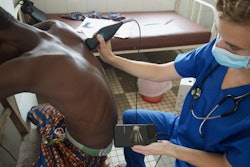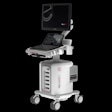Point-of-care ultrasound (POCUS) can accurately identify clinically significant pneumothorax (PTX) in emergency trauma patients, suggest findings published July 17 in the Journal of Emergency Medicine.
Researchers led by Daniel Singer, MD, from Stony Brook University in New York, found that POCUS outperformed supine chest x-ray in finding PTX, whether it was used by experts or less-trained physicians. POCUS also led to faster exam times over x-ray and CT.
"These results highlight the necessity for ongoing real-time quality improvement," Singer and colleagues wrote.
While CT is the standard for diagnosing PTX, the researchers noted that this can be time-consuming due to transferring patients to imaging, especially if they are unstable. And while chest x-ray is another modality used for PTX detection, previous reports suggest that it can miss up to half of PTX cases.
POCUS has become a useful emergency imaging tool that can be used at the bedside for trauma assessment. Previous studies showed the modality’s effectiveness for PTX, including high sensitivity and specificity.
Singer and colleagues compared the sensitivities of POCUS and portable chest x-ray in detecting all cases of PTX, including cases with clinically significant PTX.
The researchers reviewed retrospective data over a three-year period at a level I trauma center, focusing on high-severity trauma patients. They determined the presence or absence of PTX by either CT findings or a clinician's description of a “rush of air” on tube thoracostomy placement. They also defined PTX as clinically significant if the patient needed tube thoracostomy within 2.5 hours of triaging.
Final analysis included 924 patients, 40 of whom had clinically significant PTX. POCUS outperformed plain chest x-ray, whether it was used by fellowship-trained or less-trained physicians.
Comparison between POCUS, chest x-ray for PTX detection | |||
Measure | Plain chest x-ray | POCUS (less-trained physicians) | POCUS (fellowship-trained physicians) |
Sensitivity | 48.1% | 68% | 84% |
Specificity | 99% | 100% | 100% |
POCUS also achieved a positive predictive value of 100% for both novice and experienced users and a negative predictive value of 14.3% for less-trained users and 25% for fellowship-trained users.
Finally, the time to acquisition of a POCUS exam was 9.9 minutes compared with 16.9 minutes for chest x-ray and 76.6 minutes for CT.
The study authors highlighted that thoracic POCUS can be performed accurately by non-fellowship trained emergency department providers with greater attention to technique.
“There may be a need for more supervision, recurrent hands-on practice, and establishment of a consensus protocol on location for scanning,” they wrote.
The full study can be found here.




















